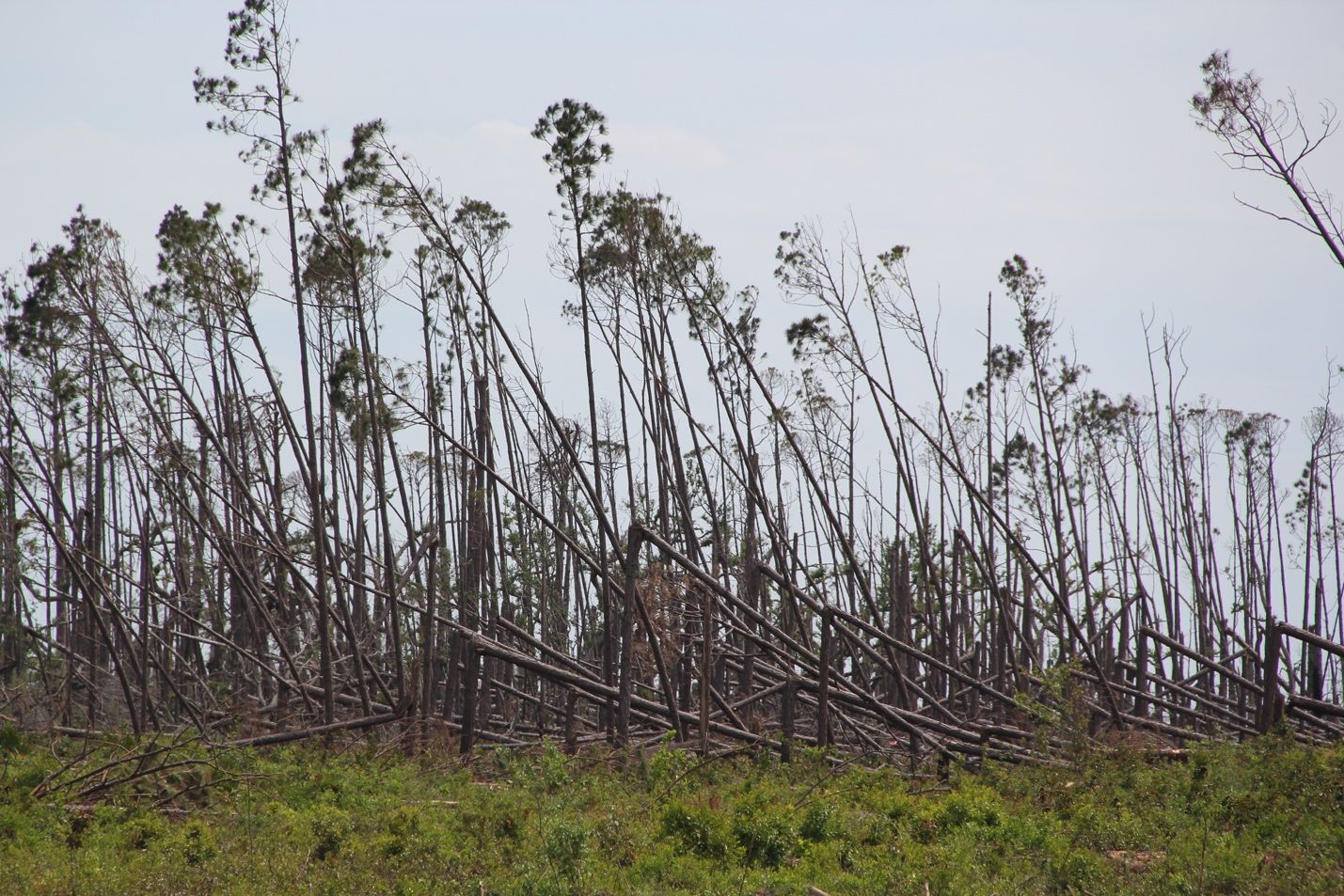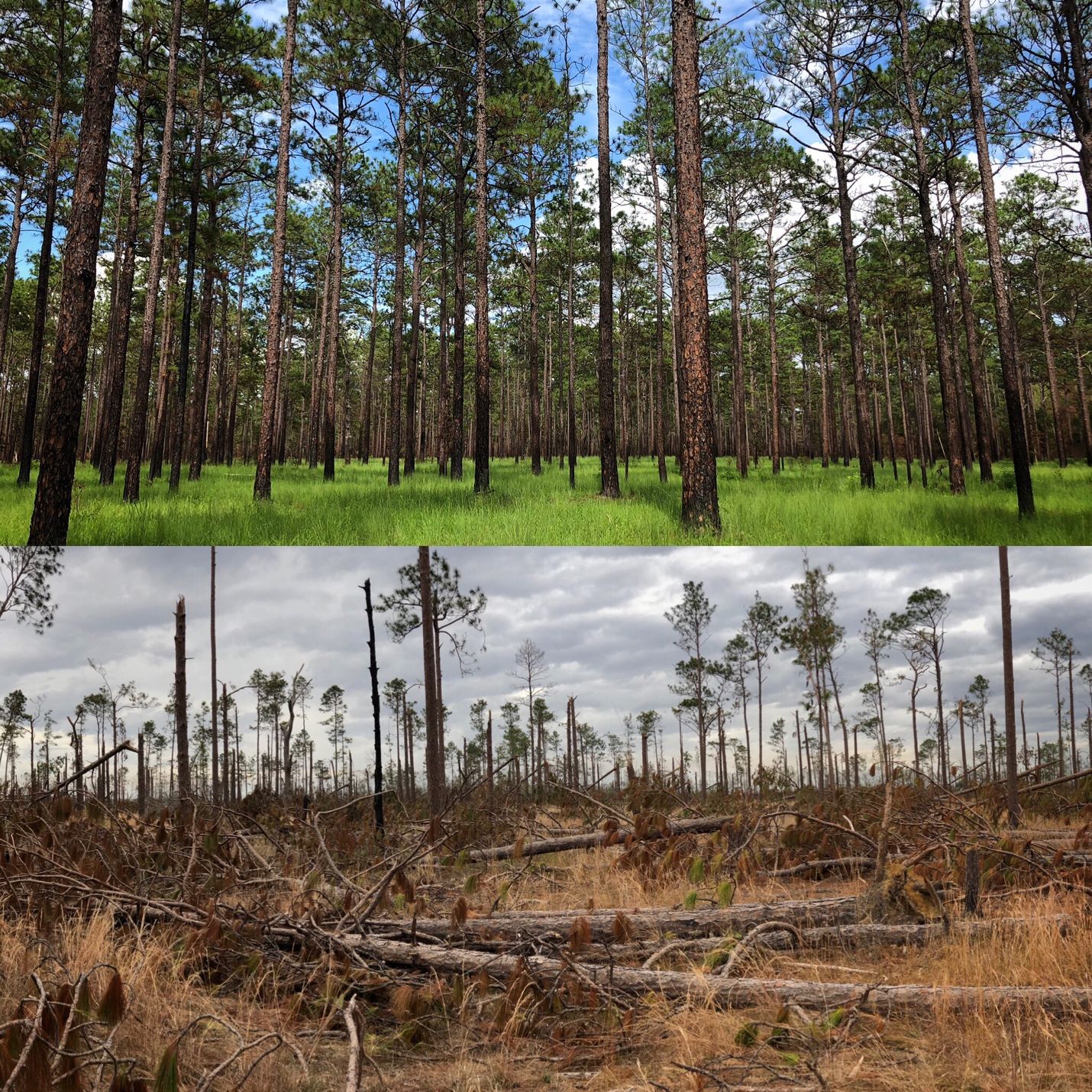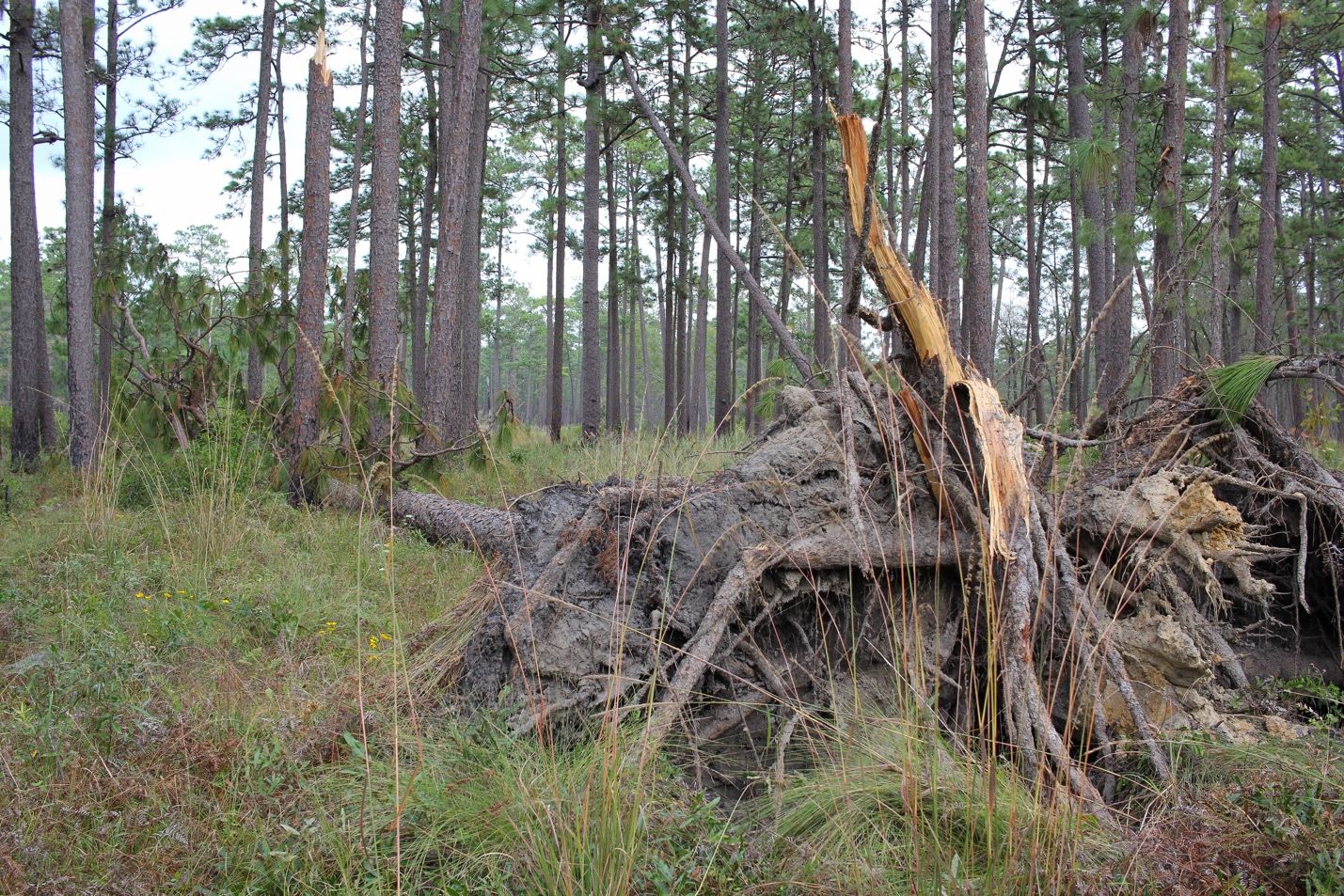In a Nutshell
Hurricanes and tropical storms can significantly alter forested and non-forested areas, creating unique hazards and considerations for wildland firefighters and prescribed burners. Before responding to wildfires and planning prescribed fires, fire managers should anticipate how changes caused by tropical storms and hurricanes will affect fire behavior, smoke, hazards to personnel, and access to the fire.
Introduction
Strong hurricanes and tropical storms periodically alter forests and other natural areas of the United States (Figure 1). Although they are natural disturbances, climate change models predict the frequency and intensity of hurricanes and tropical storms will increase in the future (Kunkel et al. 2020). These storms have the potential to cause both short- and long-term structural changes, such as increasing fuel loading and knocking down trees. These structural changes have important implications for fire behavior and wildfire risk. To ensure firefighter and public safety, it is important to understand and anticipate how ecosystem changes caused by hurricanes and tropical storms will affect fire behavior, smoke, hazards, and access to burn units. This publication is intended for prescribed burners, landowners, and firefighters. It summarizes the relevant scientific literature on the topic and synthesizes lessons learned from wildland firefighters and prescribed burners who have managed fires in storm-impacted areas.

Credit: David Godwin, UF/IFAS
Impacts on Fire Behavior and Fuels
Hurricanes and tropical storms can substantially increase fuel loading. All fuels, including fine to coarse (1-hour to 1000-hour, Table 1) dead surface fuels, could greatly increase during and shortly after storms. Changes to the arrangement, density, and types of fuels affect fire behavior. For example, tipped-over trees and snapped-off treetops with leaves or needles still attached can lead to increased fire intensity and a greater risk of scorching or torching the remaining overstory, in addition to increased risk of embers spotting (the ignition of new fires by wind-carried embers or sparks) into adjacent areas. High winds during a storm can strip canopy fuels from trees and deposit them on the ground. Some managers have calculated that the storm-driven deposition of surface fuels can be equivalent to one extra year of rough (i.e., understory vegetative growth), resulting in increased fire behavior and smoke production.
Table 1. The fuel lag time of dead fuels refers to the amount of time needed for the fuel to reach 2/3 of a new equilibrium moisture content by becoming wetter or drier. In general, this metric provides fire practitioners with estimates of how long it will take fuels to respond to changing environmental conditions.
Downed trees and vegetative debris can carry fire across human-made firebreaks and natural breaks such as streams and wetlands (Stanturf et al. 2007). Shortly after a storm, standing pines can be particularly flammable due to dripping resin caused by structural damage during the storm. This resin can carry surface fires up tree trunks, increasing torching and spotting potential. Reduced canopy cover and shading can increase solar heating and drying of the fine 1-hour dead and living fuels, increasing the likelihood they will ignite and spread fire. Following Hurricane Michael in northwest Florida, some fire managers reported that the rapid changes in canopy cover and decreases in surface fuel moisture led to unanticipated fire behavior in sites previously used as natural fire breaks (hardwood hammocks, creeks, ravines, and swamps). The greater light and nutrient availability post-storm can also increase growth of understory vegetation and vining plants (Wade et al. 1993). This rapid increase in live fuels can further elevate fire behavior, especially as the time-since-storm increases. Fire managers have also observed increases in invasive plant species following storms and storm-related recovery activities. Some of these species, such as cogongrass (Imperata cylindrica), can significantly impact understory fuels and fire behavior.
There are short- and long-term (months to years) changes in fuels following hurricanes and tropical storms. Delayed overstory and understory mortality can result from salt-water intrusion, salt spray, flooding, leaf/needle loss, wind-loosened root systems/wind throw, and post-storm insect damage (Coyle and Lord 2020). Fire managers should consider the dynamic nature of fuel loading that can result from delayed mortality, changes in forest structure (e.g., fallen snags), and post-storm growth of vegetation.
In contrast, post-storm fuel loading, and, in turn, fire intensity, can also decrease over time if there are fewer pines and fire-tolerant hardwoods in the canopy. This is because reductions in canopy cover and tree density can reduce needlecast and depositing of flammable hardwood leaf litter onto the forest floor. In some cases, fire managers have also reported that fire spread can be limited after a storm because the trunks of downed trees sometimes act as fuel breaks, reducing surface fuel continuity within a stand. Depending on the impacts, changes in potential fire behavior (both increases and decreases) can last for years.
Impacts on Smoke
Smoke management is particularly important when burning after a storm because of increases in the total load of large-diameter fuels on the ground, standing or leaning. Large-diameter (often referred to as 10,000-hour fuels) and/or wet fuels may be long-duration smoke sources with heavy smoke production that can reduce visibility along roadways and impact communities. The likelihood of heavy smoke production is not always obvious in the short-term but can become a problem as fuels decay in the months and years following a storm. Some managers have noted that smoke management from heavy fuels is more of a concern two years rather than one year after a storm. This is because storm-damaged trees were often too “green” one-year post-storm to ignite. In addition, post-storm recovery activities such as salvage logging, timber harvesting, road clearing, and piling of vegetative debris, can create new sources for long-duration smoke production. Wet fuels following heavy rains, flooding, storm surge or decreases in evapotranspiration can result in prolonged smoldering and increased total smoke production. Smoke from prescribed fires or wildfires can travel to and affect areas well beyond the boundaries of the area burned. It is important to conduct smoke-management screening before burning to protect the smoke-sensitive sites in the area. Furthermore, weather forecasts for several days after the burn should be monitored to anticipate extended smoke production from smoldering fuels.
Impacts on Hazards
Storm surge, wind, flooding, erosion and cleanup activities can transport, expose or leave new and unexpected hazards in natural areas. Extreme fire behavior can result from these foreign materials. For instance, hazardous materials, such as fuel tanks, propane tanks, telephone poles, tires, cars, boats, appliances and building debris, can produce toxic smoke or explode when exposed to fire. Furthermore, animals such as bears, snakes, alligators, livestock, and stinging/biting insects may be displaced after a storm and present or active in new locations.
Damaged trees are one of the most common yet serious hazards that result from storms. Aptly named “widow-makers,” snags, leaning trees, and dangling branches can fall and injure personnel. Additionally, downed trees and limbs that are bent under tension can “spring back” when being moved, cut, or while burning and cause injury. Firefighters and other personnel should be cautious in areas with poor footing, sharp pointed limbs, snags, vines, and other hazards. Snags, whether burning or not, are well-known hazards to wildland fire managers. It may be beneficial to fell snags near firebreaks to increase personnel safety.

Credit: Chad Anderson, National Park Service
Impacts to Access
It is important to conduct reconnaissance before burning to determine how access to and within an area has changed after a storm. This information will inform ignition strategies and help ensure firefighter safety. Hurricanes can result in large areas of blowdown (e.g., 8,800 square miles after Hurricane Hugo) that can block or hinder access for fire operations and emergency medical response (Saveland and Wade 1991). Downed trees, flooding, and washouts can delay or prevent personnel, vehicles, and equipment from accessing the periphery and interior of units and forested areas. Experience has shown that having high-quality roads that are crowned and graveled before a storm can improve access after storms (Barlow et al. 2020). Stumps and heavy fuels can cause heavy equipment, ATVs/UTVs, and trucks to become stuck and can also slow fireline construction by both hand crews and equipment. These obstacles could also make interior ignition significantly slower or nearly impossible for crews on foot or ATV/UTV, potentially necessitating the use of remote or aerial ignition devices. Following Hurricane Michael, it was reported that hand crews and other personnel traveling on foot were more susceptible to heat stress and fatigue as a result of reduced canopy shading, increased physical exertion, and difficultly with access and movement within post-hurricane-damaged sites.

Credit: David Godwin, UF/IFAS
Conclusion
Landowners and fire managers should understand and prepare for the effects of hurricanes and tropical storms on the behavior of wildfires and prescribed fires. After storms, fuels are often significantly altered, resulting in novel and unexpected fire behavior. Additionally, new hazards are often present within natural areas, posing safety concerns for prescribed burners and firefighters. Detailed planning, extreme care, and increased awareness should be used when visiting or working in these areas following a storm.
Acknowledgements
The authors would like to thank the following individuals who provided important fire-management information that supported the development of this publication: Brett Williams, David Printiss, Matt Snider, and Mark Melvin. The authors would also like to thank two anonymous reviewers as well as Chad Anderson for permission to use his photographs.
Literature Cited
Kunkel, K. E., D. R. Easterling, A. Ballinger, S. Billing, S. M. Champion, D. R. Corbett, K. D. Dello et al. 2020. North Carolina Climate Science Report. Ashville, NC: North Carolina Institute for Climate Studies. 233 p. https://ncics.org/wp-content/uploads/2020/06/NC_Climate_Science_Report_FullReport_Final_revised_May2020.pdf
Stanturf, J. A., S. L. Goodrick, and K. W. Outcalt. 2007. Disturbance and Coastal Forests: A Strategic Approach to Forest Management in Hurricane Impact Zones.” Forest Ecology and Management 250 (1–2): 119–135. https://doi.org/10.1016/j.foreco.2007.03.015
Wade, D. D., J. K. Forbus, and J. M. Saveland. 1993. “Photo Series for Estimating Post-Hurricane Residues and Fire Behavior in Southern Pine.” General Technical Report SE-82. Ashville, NC: U.S. Department of Agriculture Forest Service, Southeastern Forest Experiment Station. United States.
Coyle, D., and L. Lord. 2020. “Blowing in the Wind: Advantages of Longleaf Pine in Wind Storms.” The Longleaf Partnership Council. http://www.americaslongleaf.org/media/c2xp2jgw/llp-windstorm-fact-sheet-2020.pdf
Saveland, J. M., and D. D. Wade. 1991. “Fire Management Ramifications of Hurricane Hugo.” In: Proceedings: 11th Conference on Fire and Forest Meteorology; April 16–19; Missoula, MT. Society of American Foresters, Bethesda, MD. Pages 124–131. https://www.fs.usda.gov/treesearch/pubs/5134
Barlow, B., M. Andreu, C. Asaro, A. Maggard, and J. Auel. 2020. “Pine Forest Landowners Guide.” In Hurricane Preparation and Recovery in the Southeastern United States. Technical Report edited by McNulty, Steven; Gavazzi, Michael; Matchett, Karin, eds.Asheville, NC: U.S. Department of Agriculture Forest Service, Southern Research Station. https://www.climatehubs.usda.gov/hubs/southeast/topic/hurricane-preparation-and-recovery-southeast-us